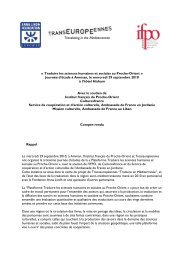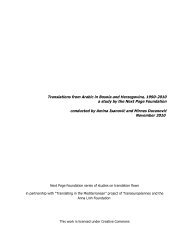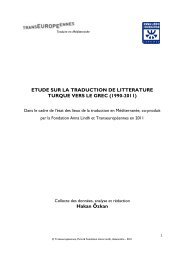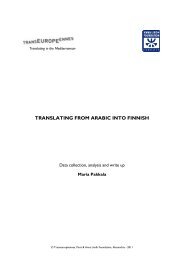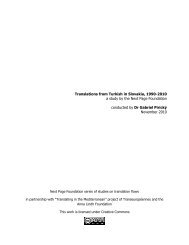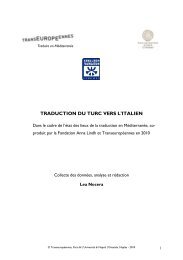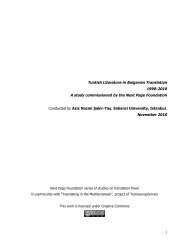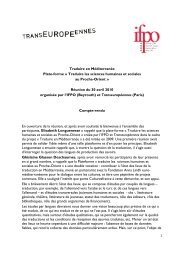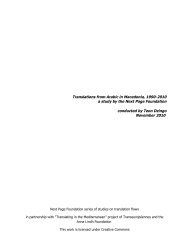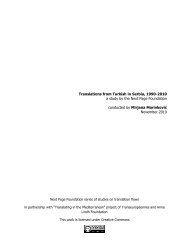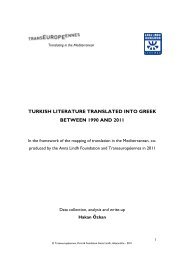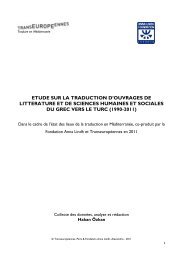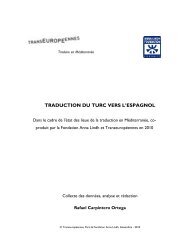TIM 2010 EastEuro-Arabic Next Page Foundation - Transeuropéennes
TIM 2010 EastEuro-Arabic Next Page Foundation - Transeuropéennes
TIM 2010 EastEuro-Arabic Next Page Foundation - Transeuropéennes
- No tags were found...
You also want an ePaper? Increase the reach of your titles
YUMPU automatically turns print PDFs into web optimized ePapers that Google loves.
Introducir al alumno al conocimiento de las buenas prácticas y recomendaciones paralograr un diseño flexible utilizando técnicas de programación orientadas a objetos enentornos empresariales.Resolución de Problemas y Algoritmos. Paradigma de programación orientada aobjetos. Estrategias de diseño de algoritmos. Estrategias de implementación.Al aprobar la materia el alumno podrá desarrollar programas utilizando Objetospartiendo de la problemática de la persistencia, concurrencia, performance y altadisponibilidad.Materia: Web-Text Mining.Día: viernes (TN).Profesor: Juan Azcurra.Contenido y Objetivos:Introducir al alumno al conocimiento de recuperación de información desde fuentesestructuradas y no estructuradas. Familiarizarse con las técnicas de preparación de datospara la aplicación de Web Mining. Identificar los distintos enfoques de Web Mining.Aplicar distintas técnicas de búsqueda de patrones sobre la información no estructurada.Historia de la World Wide Web. Introducción a Web Mining. Conceptos deRecuperación de Información. Técnicas de Crawling. Proceso de Web Mining. WebContent Mining. Web Usage Mining. Web Structure Mining. Construcción y evaluaciónde modelos. Introducción a Text Mining. Recuperación de contenido no estructurado.Clustering de Texto. Medidas de información. Aplicaciones de Text Mining.Al aprobar la materia el alumno podrá aplicar técnicas y herramientas para descubrirpatrones en la información que está almacenada en la Web (sobre su contenido o uso).Diseñar e implementar aplicaciones de extracción de conocimiento de contenido noestructurado almacenado en grandes volúmenes de información.Materia: Tecnología de la Información.Día: jueves (TT).Profesor: Carlos Martínez.Contenido y Objetivos:Esta materia pretende ofrecer un camino de ingreso a los estudiantes, informando lautilidad de la informática, en la vida actual, como así también las tendencias futuras ylas perspectivas de esta nueva ciencia, que todavía no ha cumplido un siglo de vida. Endicha materia se mostrarán las diversas aplicaciones, de la “TECNOLOGÍA DE LAINFORMACIÓN” tanto en los negocios, como en otros ámbitos del desarrollo humano,tales como el gubernamental, el académico, el médico, el turismo, el arte, lascomunicaciones sociales, etc.Materia: Plataformas de TI 3 (Análisis De Plataformas).Día: martes (TN).Profesor: Carla Ares.Contenido y Objetivos:Que el alumno conozca y pueda seleccionar las diferentes alternativas de sistemasoperativos, lenguajes de programación y base de datos disponibles en el mercado. Seanalizarán tanto las soluciones comerciales como las OpenSource. Haciendo énfasis enlas cualidades y capacidades de cada una.El alumno comprenderá para qué se utiliza cada uno de estos sistemas, en qué ámbito,bajo qué circunstancias, ventajas y desventajas de los mismos.
discrepancy to the incompleteness of the <strong>Arabic</strong> data and envisage an error margin of about20 percent. In addition, due to the large number of Muslim population, some countries of theCEE remain a stable consumer of Islam-related publications translated into their languages.In fact, more than ½ of the 1919 titles translated into CEE languages from <strong>Arabic</strong> are in oneway or another related to Muslim religion.The most translated source language seems to be Polish with 47 titles, followed byBosnian and Slovak with 15 titles each. We were unable to identify even a single Lithuaniantranslation after 1989.Translations into <strong>Arabic</strong>, 1989-<strong>2010</strong>50454035302520non-fictionliterature151050BosnianBulgarianCroatianHungarianCzechLithuanianMacedonianPolishRomanianSerbianSlovakSlovenianregional anthologiesLiterary texts, predominantly by 20 th and 21 st century authors, are approximately twice ascommon as non-fiction translations. It should be noted that the percentage of dramaticworks translated into <strong>Arabic</strong> from CEE languages is considerably higher than translations ofthe same genre in the other direction, i.e. from <strong>Arabic</strong>.Most of the translations included here are done via an intermediary language. After 1989,English and French have replaced Russian as the major intermediary languages fortranslation. The reasons for this are twofold. First, the general lack of translators from CEElanguages but also the lack of cross-border communication between translation communitiesin the different Arab countries make it difficult for publishers to identify appropriatetranslators. An editor in Egypt can only come to know of the existence of, say, a Czechtranslator in Syria or become acquainted with his/her work by accident. Since only a few CEEcountries have programs that provide information on their national literatures, an Arab editorhas no channels for getting to know, let alone reviewing, an East European author except forin English or French editions. However, the phenomenon of mediated translation iswidespread in the Arab world and is used even for languages for which translators should beavailable in principle, such as German, for example. Often, translations are carried outthrough intermediary languages without appropriate reference being made.7
the Arab world. To achieve a notable impact on the dynamics of translations, these programsneed time to establish working relations with Arab publishers as well as to cultivate asufficiently large number of translators who would create their market within giventranslation projects.Second, funding comes from public and private sources in the Arab world, which operatewithin the general framework of contributing to the advancement of knowledge and culturein the Arab world. In the case of CEE languages, these include the National TranslationProject of the Supreme Council for Culture in Egypt, the General Egyptian BookOrganization, the National Council for Culture, Arts and Letters (NCCAL) inKuwait and the Syrian Ministry of Culture. Due to the lack of transparency of many ofthese programs, it is difficult to establish the exact number of translations they havesupported from CEE languages.While the European-led programs routinely provide grants for translations on the basis ofopen competition for publishers’ subventions, their Arab counterparts often commission titlesof their choice or publish the books themselves. Arab-funded programs typically ensurelower cover prices of the funded books as part of their policy for promoting wider audienceaccess.A relatively recent addition is the Encounters program 8 of the <strong>Next</strong> <strong>Page</strong> <strong>Foundation</strong>. Itsspecial focus on encouraging the translation flow between East European languages and<strong>Arabic</strong> makes it unique in the translation funding landscape. The program supportstranslations in both directions – from <strong>Arabic</strong> into East European languages and from theselanguages into <strong>Arabic</strong> by co-funding mutual translations of contemporary prose, essays andtexts in the humanities. Since the mere provision of a limited number of mutual translations– while a desirable aim in itself – is believed to have a limited impact, the broader approachis to supplement the grant scheme with other activities such as direct encounters with keyorganizations (at workshops, fairs and other events) and a survey of the translation policiesin both regions. So far the program has supported the publication of seven book titles andtwo journal issues 9 of translations from <strong>Arabic</strong>. For a detailed account of the program’sdevelopments regarding translations into <strong>Arabic</strong>, see section 2.6. below.It should be noted that, with few exceptions, funding programs focus on financing thepublication itself (copyrights, translation and sometimes even the printing costs), while otherforms of support such as promotion budgets, fellowships for translators, participation inevents, readings and authors’ visits, etc. are almost completely lacking.3. Some notable initiatives and channelsSince the diversity of the cultural and literary ties between the 12 CEE countries and theArab-speaking world makes general statements on the factors that affect these translationsimpossible, we have chosen instead to consider several notable cases of successful orimportant initiatives and channels. The list below is by no means exhaustive; rather, eachexample emphasizes a specific aspect of publishing this kind of translation.3.1. Consistent publishing policy8http://www.npage.org/article172.html9For a full list of supported projects, visit http://www.npage.org/article202.html9
As already noted, very few Arab publishers demonstrate a consistent policy in publishingtranslations, and even fewer regularly publish translations from any of the CEE languages.Several publishers in the bibliography seem to have a lasting interest in CEE translations.The private publisher Dar al-Mada from Beirut/Damascus is a distinguished house for qualityliterature. Other publishers with more than one title on the list include Dār al-Ḥaṣād fromSyria (with translations from Polish and Romanian), the Ministry of Information of Kuwait(from Bulgarian and Slovak), the National Council for Culture, Arts and Literature in Kuwait(almost all languages). A recent new endeavour is the Sphinx Agency from Cairo, which actsboth as a rights agency, a publisher and a book-marketing body and which strives to publishtranslations into <strong>Arabic</strong>. Another publisher that has recently expressed interest in CEEtranslations into <strong>Arabic</strong> is Cadmus (Syria), which so far has a number of translations fromother languages in its catalogue.3.2. Literary anthologiesOne of the biggest recent translation events is the publication of the V4 Anthology (January2009) under the title Qasa´is min qalb Uruba (Stories from the Heart of Europe), in whichfiction works by young famous writers from Visegrad countries (the Czech Republic,Hungary, Poland and Slovakia) were selected and translated into <strong>Arabic</strong>. The book was aproject by the Centre for Information on Slovak Literature and several ministries and waspublished by the Sphinx Agency. It includes contributions by Jan Balabán and StanislavBeran (Czech Republic), Margit Halász and Szilárd Podmanitzky (Hungary), Pawel Huelleand Daniel Odija (Poland), Karol Horváth and Ursula Kovalyk (Slovakia). It was edited byPál Békés and Ina Martinová (chief editors), with Ivory Rodriguez and Piotr Marciszuk. Theanthology was launched in Cairo and Alexandria with a series of events organized by theCentre for Information on Slovak Literature and Literature across Frontiers.Another notable event is a regional anthology of contemporary prose, published again bySphinx and supported by the <strong>Next</strong> <strong>Page</strong> <strong>Foundation</strong>. Voices from the Faultline: A BalkanAnthology (<strong>2010</strong>) is an abridged version of an anthology edited by A. Johnson and ZakalinNezic, originally published by Zayupress in 2005 and including young literary voices fromSoutheastern Europe.Despite their importance for introducing contemporary writing from the CEE region to <strong>Arabic</strong>audiences, it must be noted that both anthologies were edited outside of the Arab world andthat they enjoyed financial support from European-based funders.3.3. PeriodicalsLiterary and other periodicals are an important channel for introducing new literatures andauthors. However, there is a dearth of information on the role of Arab-based periodicals withan interest in CEE writings.The most popular literary weekly magazines in the Arab world Akhbar al-Adab, edited byGamal al-Ghitani, deserves special mention for having begun to publish classic Slovak writersand poetry regularly. One issue was dedicated entirely to Slovak literature (April 2008). Thefirst contact was made through the Slovak Embassy in Cairo. The selection and translationswere done by Kh. al-Biltagi, who closely cooperates with the Slovak Literary Centre. Al-Ghitani’s Pyramid Texts were published in Slovak by Drevo a Srd with <strong>Next</strong> <strong>Page</strong>’s supportand launched in Bratislava in the presence of the author.10
Polish translations of poems by Czesław Miłosz, Tadeusz Różewicz, Wisława Szymborska,Zbigniew Herbert, and many others translated by Hātif al-Janābi appear in variousperiodicals such as Aṯ-Ṯaqāfa al-aǧnabiyya (Baghdad), Barīd al-Ǧanūb (Paris), An-Nahǧ(Damascus), Al-Madā (Damascus), Faradis (Paris), and others. Some translations, poemsand short stories can be found on the Internet, primarily on the cultural siteswww.elaph.com and www.adabfan.com or on the sites of magazines such aswww.nizwa.com (Oman) and www.alarabimag.com (Kuwait). Translations of Polish plays byIreneusz Iredyński, Sławomir Mrożek, Tadeusz Różewicz and Witold Gombrowicz have beenpublished in periodicals such as Al-Aqlām or Ath-Thaqāfa al-Ajnabīya (Iraq), Nizwa (Oman),and others.3.4. The role of the immigrant and expatriate communitiesContrary to what one might assume, migrants between CEE and the Arab world in bothdirections do not play a decisive role in boosting translations. This is due to the fact that thiskind of migration is typically labour migration or is related to receiving education in thetechnical or hard sciences. While migrant communities do have a role to play in sustainingbusiness and cultural relations between the countries, they are usually not sufficientlyequipped for or interested in pursuing a career in publishing or translation.One notable exception is the publisher Dar Ibn Rushd, which was founded in 1991 in Praguewith the original intention of publishing literature from the “Orient”. It publishes textbookson Oriental languages, dictionaries, translations of literary works, but also works by Czechauthors and journalists related to its publishing focus. Its owner, Charif Bahbouh, is also atranslator from and into <strong>Arabic</strong> who has already published his translation of Czech shortstories and tales and is planning to publish more literary works.4. Notes and bibliographies by countryBosnian into <strong>Arabic</strong>Bosnia and Herzegovina has a special position vis-à-vis the <strong>Arabic</strong> language. Compared tothe other countries in Southeast Europe, the position of Oriental languages (<strong>Arabic</strong>, Turkishand Persian) within the cultural context of BiH is fairly distinctive. The presence of thoselanguages can be traced back to the period of Ottoman rule (1463-1878) in the country.Over the centuries, Bosnia was plurilingual in many regards; besides Bosnian, several otherlanguages circulated throughout its cultural area, not only those belonging to the Orientalmilieu, but also Latin, German, Church Slavonic and, to some extent, Italian. Over the courseof Ottoman rule in Bosnia, Turkish was considered the language of administration, Persianthe language of poetry, while <strong>Arabic</strong> was predominantly used in scholarly works on theology,philosophy, philology, and science, apart from being the language of Muslims’ religiousrituals and their Holy Book. As the result of the particular influence of <strong>Arabic</strong>, a specific formof literature was developed in the 17 th century, known as alhamijado (Spanish: aljamiado)literature. Works belonging to this group are Bosnian popular language texts written in<strong>Arabic</strong> script. Bosnians writing in the <strong>Arabic</strong> language (predominantly Bosnian Muslims, i.e.Bosniaks) also prominently contributed to the intellectual development of Islamic civilization.Works produced in Oriental languages in Bosnia are regarded as a corpus of enormoussignificance for literary, historical, juridical and other studies.11
While there is no data available on the exact number of translations from Bosnian into<strong>Arabic</strong>, anecdotal evidence suggests that Arab readers are familiar with Bosnian authors andthat their works enjoy a rather favorable reception. In a lecture at the Faculty of Philosophyin Sarajevo (October 28, <strong>2010</strong>), the most productive translator of works from South Slaviclanguages (Bosnian, Serbian, Slovenian and Macedonian) to <strong>Arabic</strong>, Dr. Ğamāl al-Dīn SayyidMuhammad, emphasized the avid interest of Arab audiences, especially Egyptian readers, inworks written by Bosnian authors. Ğamāl al-Dīn Sayyid Muhmammad and Isma`īl Banduraare currently the most productive translators of literary and scholarly works from Bosnian to<strong>Arabic</strong>. 10The presence of Bosnian authors writing in <strong>Arabic</strong> and the interest of Arab readers inBosnian culture can be understood on the basis of the special position of the <strong>Arabic</strong> languagein BiH.Although the Index Translationum does not list a single translation from Bosnian after 1989,we were able to identify the following publications:1. |isr `ala Nahr Drina / Ivo Andrić. Original title: Na Drini ćuprija (The Bridge on theDrina)2. Riwaya min Madina Trafnik / Ivo Andrić; Original title: Travnička hronika (BosnianStory)3. Nazariyya al-'ibda` al-mah\ariyya fi al-Wilayat al-Muttahida / EsadDuraković; Damascus: Ittihad al-kuttab al-`Arab, 1989. Original title: Poetika arapskeknjiževnosti u SAD (Poetics of <strong>Arabic</strong> Literature in the USA)4. Tariq 'Ilhami 'ila al-mawt / Rešad Kadić; translated by Ğamāl al-Dīn SayyidMuhammad. Al-Qahira: Dar al-sabah, 1992. Original title: Ilhamijin put u smrt(Ilhami’s Road to Death)5. Kana ya ma kana wa qisas al-'ukra / Nedžad Ibrišimović; translated by Ğamāl al-Dīn Sayyid Muhammad. Al-Qahira: al-Markaz al-qawmi li al-tar\ama, 2007. Originaltitle: Bio jednom jedan (Once upon a Time There Was a Man)6. Al-Wala'iq al-`arabiyya fi Dar al-mhfuzat bi madina Dubrufnik / BesimKorkut; translated by Muhammad al-`Arna`ut. Al-Qahira: al-Ma\lis al-'a`la li allaqafa,2008. Original title: Arapski dokumenti u Državnom arhivu u Dubrovniku(<strong>Arabic</strong> Documents in the Archive of Dubrovnik)7. Al-Šahid / Zilhad Ključanin; translated by Isma`il Bandura. Jordan, 2008. Originaltitle: Šehid8. Al-'adab al-nalri li al-Busna wa al-Harsak bi al-lugat al-šarqiyya / AmirLjubović and Sulejman Grozdanić. Al-Qahira: al-Markaz al-qawmi li al-tar\ama, 2009.Original title: Prozna književnost Bosne i Hercegovine na orijentalnim jezicima (ProseLiterature of Bosnia and Herzegovina Written in Oriental Languages)9. Al-Na'im al-ha\ari / Mehmedalija Mak Dizdar; translated from English 'Ilyas Farkuh.Kuwait: The <strong>Foundation</strong> of Abdulaziz Saud Al-Babtin’s Prize for Poetic Creativity,<strong>2010</strong>. Original title: Kameni spavač (Stone Sleeper)10. Darwiš wa al-mawt / Meša Selimović. Original title: Derviš i smrt (Darwish andDeath)10 Apart from very competent translations from Bosnian, Dr. Ğamāl al-Dīn Sayyid Muhammadcontributes original scholarly works on the culture of Bosnia and Herzegovina and other South Slaviccountries. See Sayyid Muhammad, |. (<strong>2010</strong>). Prozna književnost Bosne i Hercegovine na orijentalnimjezicima [Bosnian Literature in Oriental Languages] (trans. from <strong>Arabic</strong>, biography and bibliography ofthe author: Velida Mataradžija), Signs of the Time, Spring <strong>2010</strong>, Vol. 13, 164-173 pp.12
11. `Ilm al-šarq / Esad Duraković; translated by `Adnan Hasan. Kuwait: The<strong>Foundation</strong> of Abdulaziz Saud Al-Babtin’s Prize for Poetic Creativity, <strong>2010</strong>. Originaltitle: Orijentologija (Orientology)Bulgarian to <strong>Arabic</strong>Despite a long tradition of literary connections between Bulgaria and then-friendly Arabcountries dating from before 1989, we were unable to identify any translations other thanthose listed in the Index Translationum. A notable recent event is the publication of anacademic study on the history of the Roma people in the Ottoman Empire by the prominentBulgarian Roma scholars Elena Marushiakova and Vesselin Popov. The book was translatedinto <strong>Arabic</strong> via its English version.The bibliography below also contains three plays by two of the most prominent Bulgarianauthors of 20 th century, one book for children as well as two peculiarities: a historical bookon Bulgaria published in <strong>Arabic</strong> by the state-owned Sofia Press that was dedicated topublishing Bulgarian authors in other languages as well as a popular non-fiction bestsellerabout the Bulgarian fortune-teller Vanga.1. Karanavilov, Ivrem: Maqalat Moukhtarat [<strong>Arabic</strong>] / Mikhail I'ed / Dimashq: DārHutin [Syrian Arab Republic], 1989. 245 p. Bulgarian2. Hristov, Hristo; et al.: Stranici ot bălgarska istorija [<strong>Arabic</strong>] / Sofija: Sofija-pres[Bulgaria], 1989. 208 p. Bulgarian3. Dimov, Dimităr: Nisā' lahunna mādī [<strong>Arabic</strong>] / Muḥammad Nūr al-Dīn / Kuwait:Wizārat al-I‘lām [Egypt], 1991. 119 p. English: Women with a past [orig. Bulgarian]4. Dimov, Dimităr: Nisā' lahunna māḍi [<strong>Arabic</strong>] / Muḥammad Nūr Al-Dīn / Al-Qāhirah:Maṭābi‘ Akhbār Al-Yūm [Egypt], 1991. 119 p. English: Women with a past [orig.Bulgarian]5. Dimov, Dimităr: Nisā´ lahunna māḍi [<strong>Arabic</strong>] / Muḥamad Nur al Dīn / Kuwait:Ministry of Information [Kuwait], 1991. 116 p. Bulgarian6. Karalijčev, Angel: Al-ṣadāqah al-abadiyyah wa qiṣaṣ ukhrā [<strong>Arabic</strong>] / ‘Isā Lashmās /Dimashq: Wizārat al-Thaqāfah [Syrian Arab Republic], 1995. 107 p. Bulgarian7. Stojanova, Krasimira: Fānghā (Vanga) [<strong>Arabic</strong>] / R. ‘Alā´ al-Dīn / Dimashq: Dār ‘Alā´ al-Dīn [Syrian Arab Republic], 2000. 122 p. Bulgarian: Vanga8. Stratev, Stanislav: Ḥammām rūmānī [<strong>Arabic</strong>] / Muḥamad Sa‘īd Al-Jūkhadār / s. l.: s.n. [Kuwait], 1993. 1 v. Bulgarian9. Stratev, Stanislav: Sitra min al mukhmalin [<strong>Arabic</strong>] / Muḥamad Sa‘īd Al-Jūkhadār / s.l.: s. n. [Kuwait], 1994. 1 v. Bulgarian10. Elena Marushiakova and Veselin Popov: Gypsies in the Ottoman Empire, Sphinx,Cairo, <strong>2010</strong>(Note: three of the above entries in the Index are the same title published in two differentcountries in the same year and translated by the same translator)Croatian to <strong>Arabic</strong>After the proclamation of the country’s independence, the first Croatian book translated into<strong>Arabic</strong>, with English as a mediator, was a collection of war poetry U ovom strašnom času [InThis Terrible Moment], compiled by Ivo Sanader and Ante Stamać. It was translated intonumerous languages in an ambitious, politically-motivated project financed by both theMinistry of Culture and the Ministry of Foreign Affairs of the Republic of Croatia. The list13
elow also contains a work by a Croatian ambassador in Egypt as well as a translation – viaFrench – of the notable Croatian scholar and essayist Pregrad Matveijevic. A notable recentevent is the publication of the young Croatian writer Damir Karakas, thanks to the efforts ofhis translator Dr. Ossama El Kaffash.The most recent translation is Dubravka Ugresic’s Nobody’s Home, translated from Englishand published by Mahrosa Publishing in Cairo as part of a joint program between Sphinx andthe <strong>Next</strong> <strong>Page</strong> <strong>Foundation</strong>.Index Translationum lists only two translations, while we identified a total of six. The overlapbetween the two sources is only by two titles. Regarding the <strong>Arabic</strong> translations of IvoAndric, see footnote 2 above.1. Stipčević, Aleksandar: Tārīkh al kitāb [<strong>Arabic</strong>] / Muhammad AlArnāwūṭ / Kuwait:National Council for Culture, Arts and Letters [Jordan], 1993. 271 p. Croatian:Povijest knjige2. Matvejević, Predrag: Tarātīl mutawassiṭiyya [<strong>Arabic</strong>] / ‘Abd al-Jalīl Nāẓim; Sa‘īd al-Ḥanṣālī / Al-Dār al-bayḍā´: [Morocco], 1999. 1 v. French: Bréviaire méditerranéen[orig. Croatian: Mediteranski brevijar ]3. Sanader, Ivo and Ante Stamać: Hadhihi al-lahza ar-rahiba: qasa'id min Kruatiya[translation of: At This Terrible Moment: An Anthology of Croatian War Poetry 1991-1994], trans. from English Rif'at Sallam, Cairo: Al-Markaz al-Misri al-'Arabi, 1997, 197p. [orig. Croatian: U ovom strašnom času: antologija suvremene hrvatske ratne lirike]4. Štambuk, Drago, Lughat al-tamazzuq / Language of Separation, published in <strong>Arabic</strong>and English, trans. from English and foreword by Rif'at Sallam, introduction Edwar al-Kharrat, Cairo: Al-Majlis al-A'la lil-Thaqafa, 2000, 252 p. [orig. Croatian: Jezikrazdjela]5. Karakaš, Damir, Eskimo [Eskimo], trans. from Croatian Ossama al-Kaffash, Cairo:Dar al-Kalam, 2009, 111 p. [orig. Croatian: Eskimi]6. Ugresic, Dubravka: Nobody’s Home, trans. from English by Medhat Taha, Mahrosa,Cairo, <strong>2010</strong>Czech to <strong>Arabic</strong>Several works by important Czech authors such as Božena Němcová, Josef Škvorecký, JanDrda, Jaroslav Hašek, Jaroslav Seifert, and Milan Kundera were published in <strong>Arabic</strong>, primarilyin Syria, in the 1980s. This is not surprising, given the good political and economic relationsbetween Czechoslovakia and Syria during that period. In addition, more Kundera translationshave been published in Egypt, as well as one work by Miroslav Holub. Even though some ofthe works by Kundera listed here were originally written in French, we include them due tothe author’s identification with his Czech origins. One novel by Karel Čapek was alsotranslated and published in Kuwait.More recently, we have found a book by the Czech Egyptologist Miroslav Verner on thepyramids and an essay by Czech president Václav Klaus criticising global warming theories.One notable endeavour to translate Czech works into <strong>Arabic</strong> is the initiative by the owner ofthe publishing house Dar ibn Rushd in Prague, Charif Bahbouh. He has already published histranslation of Czech short stories and tales and is planning to publish more works.14
4. Székely, György: ‘Ilm ijtimā‘ al-masraḥ : rasm tārīkhī takhṭīṭī li-‘ilm al-ijtimā‘ fī far‘ minfurū‘ al-fann-al-masraḥīyah [<strong>Arabic</strong>] / Kamāl al-Dīn ‘Īd / Al-Qāhirah: Wizārat al-Thaqāfah [Egypt], 2005. 2vol. Hungarian: A Színjàték vilāge egy művészeti agtarsadalom történetének vazlata5. Fadlallah, Mihály: Utazásom..., Kutub, Beirut, 20046. Móricz, Zsigmond: Rokonok (Relations), Al-Mada, Damascus, 20047. Örkény, István: Macskajáték (Catsplay), Al-Mada, Damascus, 20048. Kertész, Imre: Angol lobogó + Jegyzőkönyv (English Flagg and Protocol), Al-Mada,Damascus, 20059. Kertész, Imre: Sorstalanság, (Fatelessness), Al-Mada, Damascus, 200510. Dragomán György: A fehér király, (The White King), Sphinx, Cairo, <strong>2010</strong>Lithuanian into <strong>Arabic</strong>The paucity of information sources regarding translations of Lithuanian authors into <strong>Arabic</strong>makes us rely exclusively on the Index Translationum, which has a peculiar list ofpublications done within the territory of and during the time of the USSR and translatedexclusively from Russian. For these reasons, we will not consider them in this study.Macedonian into <strong>Arabic</strong>According to data provided by the Statistical Bureau of the National andUniversity Library "St. Kliment Ohridski", only the poem “T'ga za jug” (Sorrow for the South),written by the Macedonian poet Konstantin Miladinov, has been translated by Fatima LahbabiLamai from Macedonian into <strong>Arabic</strong>; it was published by the Macedonian publishing houseDetska radost in the year of 1994. However, one more title is being translated at the time ofthis writing: the book originally entitled Vakufite vo Makedonija vo periodot na osmanliskotovladeenje (The Vakufs in Macedonia during the period of the Ottoman Empire), written byDr. Amet Sherif, PhD, an academic researcher at the Institute of National History of theRepublic of Macedonia. His academic publication is being translated by Taljat Kurtishi fromMacedonian into <strong>Arabic</strong> via Albanian. This translation has been commissioned and financedby the Kuwaiti Ministry of Culture.Neither the Index nor other bibliographic sources consulted contain any listings ofMacedonian translations into <strong>Arabic</strong>.Polish into <strong>Arabic</strong>It is striking that very few works of Polish belles lettres have been translated into <strong>Arabic</strong>,especially after 1990, while a relatively large number of works concerning modern theatre,especially Experimental theatre, including that of Jerzy Grotowski, have been translated into<strong>Arabic</strong>, chiefly in Egypt (more than 10 titles, three after 1989). Another topic stronglyrepresented in the translated works is history, especially that of Christianity. For example,books by the ancient historian Aleksander Krawczuk (two titles), historian of Christianity JanDobraczyński (five titles), and essayist writing on the Bible Zenon Kosidowski have beentranslated.Arab publishers also seem to be particularly interested in works by Polish Nobel prizewinners, given that a novel by Władysław Stanisław Reymont and poems by Czesław Miłoszand Wisława Szymborska have been translated (at least five collections of poems).16
A significant number of Polish plays by world-famous playwrights Sławomir Mrożek, TadeuszRóżewicz and others have been translated and published in book form (more than 10 titles).One play by Witold Gombrowicz was published in Poland (Warsaw).A few works concerning political and economical topics come mainly from the pre-1989period, when cultural and political ties between Poland and some Arab socialist countrieswere stronger than today.The most active Polish-<strong>Arabic</strong> translators are: Hanāʼ ‘Abd al-Fattāḥ (Egypt; texts concerningtheatre, plays), Kabrū Laḥdū (Syria; mostly historical essays, prose), and Hātif al-Janābi(Iraqi living in Poland; poetry). Most books have been published in Cairo, Egypt (many ofthem by the Ministry of Culture), and Damascus, Syria (most by the publishing houses Dāral-Madā and Dār al-Ḥaṣād).Many <strong>Arabic</strong> translations of Polish are scattered throughout periodicals. Poems by CzesławMiłosz, Tadeusz Różewicz, Wisława Szymborska, Zbigniew Herbert, and many otherstranslated by Hātif al-Janābi have appeared in various periodicals, including: Aṯ-Ṯaqāfa alaǧnabiyya(Baghdad), Barīd al-Ǧanūb (Paris), An-Nahǧ (Damascus), Al-Madā (Damascus),Faradis (Paris), and others. Some translations, poems and short stories can be found on theInternet on the cultural sites www.elaph.com and www.adabfan.com or on the sites ofmagazines such as www.nizwa.com (Oman) and www.alarabimag.com (Kuweit).Translations of Polish plays by Ireneusz Iredyński, Sławomir Mrożek, Tadeusz Różewicz,Witold Gombrowicz have been published in periodicals such as Al-Aqlām or Ath-Thaqāfa al-Ajnabīya (Iraq), Nizwa (Oman), and others.No Polish-<strong>Arabic</strong> book translations could be found in the Western part of the Arab world(Maghreb).At least two publications have been produced with the financial support of a Polish culturalinstitution, namely the Instytut Książki Poland within the framework of the programmesSample Translations©Poland and Program Translatorski©Poland. Title No. 12 in the “nonfiction”section is a translation of Polish journalist W. Tochman’s account of post-war Bosniain Like Eating a Stone: Surviving the Past in Bosnia, published in <strong>2010</strong> by Sphinx in a jointprogram with the <strong>Next</strong> <strong>Page</strong> <strong>Foundation</strong>.Many Polish-<strong>Arabic</strong> translations do not appear to be direct translation, but rather useintermediary languages; however, it is difficult to establish this with certainty, since this factis not always indicated by the publisher or in a library catalogue.Index Translationum lists 14 titles, while we have identified a total of 47. Dar al Kotob’sdatabase lists two titles.Fiction:1. Lem, Stanisław: Sūlārīs [<strong>Arabic</strong>]. Tr. Muḥammad Badrẖān. Damascus: Dār al-Ḥaṣād,1990 [2nd edn 1999]. [Solaris].2. Reymont, Władysław Stanisław: Hāḏihi hiya ḥayātuhum [That is their life]. Tr.Kabrū Laḥdū. Damascus: Dār al-Ḥaṣād, 2007. [Chłopi: The Peasants]3. Sienkiewicz, Henryk: Qurrat al-‘ayn fī riwāyat ilā ayn. Tr. Tūmā Ayyūb (1861-1911)via Italian (?) [Quo vadis]17
4. Various authors: Ṭāʼir al-layl: muẖtārāt min al-qiṣṣa al-būlūniyya [Night Bird: ASelection of Polish Narratives]. Tr. Akram Sulaymān. Damascus: Wizārat aṯ-Ṯaqāfaas-Sūriyya. 1997.Poetry1. Miłosz, Czesław: Madīḥ aṭ-ṭāʼir. Tr. Hātif Al-Janābī. Damascus-Beirut: Dār al-Madā,2001. [Oda do ptaka : Ode to a Bird]2. Miłosz, Czesław: Tšīswāf Mīwūš. Aš‘ār muẖtāra min dawāwīnihi. Tr. Hanāʼ ‘Abd al-Fattāḥ Cairo: Dār al-Miṣriyya al-Lubnāniyya, <strong>2010</strong> [Selected poems]3. Różewicz, Tadeusz: Māḏā yaḥduṯu li-l-nujūm. Tr. Hātif al-Janābī. Damascus: Dār al-Madā li-ṯ-ṯaqāfa wa al-Našri, 1997. [Co się dzieje z gwiazdami : What Happens to theStars. Selected poems and essays]4. Szymborska, Wisława : Aš-šā‘ir wa-l-‘ālam. Tr. Hātif al-Janābi.Damascus : Dār al-Madā li-l-ṯaqāfa wa-n-našr, 1997] [Poeta i świat: The Poet and the World. Selectedpoems]5. Szymborska, Wisława, An-nihāya wa-l-bidāya wa-qaṣā’id uẖrā, Tr. Hātif Al-Janābi.Damascus: Dār al-Madā li-ṯ-ṯaqāfa wa-n-našr. 1998 [Koniec i początek : The End andthe Beginning and other poems]Drama.1. Gombrowicz, Witold: Zawāj, Tr. George Yacoub, Warszawa: Dialog, 2004 [Ślub :The Wedding].2. Iredyński, Ireneusz and other authors: Sab‘ masraḥiyyāt ḏāt faṣl wāḥid minBūlandā. Tr. Hanāʼ ‘Abd al-Fattāḥ. 2006. [Seven plays by various authours]3. Jasiński, Bruno: Ḥafl mānīkān. Tr. Hanāʼ ‘Abd al-Fattāḥ. Cairo: Al-Hayʼa al-miṣriyyaal-‘āmma li-l-kitāb, 1997 [Bal manekinów : The Ball of Mannequins].4. Kantor, Tadeusz. Ayyatuhā l-layla l-‘aḏba: Fuṣūl Afīnyūn [Oh, Sweet Night; AvignonChapters]. Tr. Hudā Waṣfī. Cairo: Wizārat aṯ-Ṯaqāfa 1992. [?]5. Kantor, Tadeusz. Durūs Mīlānū [Milano Classes]. Tr. (?) Cairo: Wizārat aṯ-Ṯaqāfa.6. Kruczkowski, Leon: Maʼsāt Rūzinbirg [Tragedy of the Rosenbers]. Tr. ‘Abd al-‘AzīzFahmī. Cairo: Al-Maktab ad-dawlī li-t-tarjama wa-n-našr [Juliusz i Ethel : Juliusz andEthel]7. Lem, Stanisław: Nuṣūṣ min al-masraḥ al-būlandī: ṯalāṯ masraḥiyyāt tajrībiyya [Textsfrom the Polish Theatre: Three Experimental Plays]. Tr. Hanāʼ ‘Abd al-Fattāḥ, rev.Dorota Mutawallī. Cairo: Wizārat aṯ-Ṯaqāfah, 1999. [Powtórka : Repetition]8. Lem, Stanisław: Masraḥ al-khayāl al-‘ilmī [<strong>Arabic</strong>] / Hanā´ ‘Abd al-Fattaḥ / Al-Qāhirah: Al-Hay´ah al-Miṣrīyah al-‘Āmmah lil-Kitāb [Egypt], 2000. 223 p. Polish9. Mrożek, Sławomir: Al-Muhājirūn. Tr. Hanāʼ ‘Abd al-Fattāḥ. Introduction and revisionDorota Samolińska[?]-Mutawallī. Cairo: Al-Markaz al-qawmī li-l-masraḥ wa-l-mūsīqāwa-l-funūn aš-ša‘biyya. 2004. [Emigranci : Emigrants]10. Mrożek, Sławomir: At-ta‘arrī. Tr. ‘Iṣām Maḥfūẓ. Beirut: Dār al-Fārābī. 2001. [Striptease].11. Mrożek, Sławomir: At-tānġū: masraḥiyya. Tr. ‘Abd al-Karīm Nāṣīf. 1981. [Tango]12. Mrożek, Sławomir: Aṣ-ṣūra: masraḥiyya. Tr. Nadīm Mu‘allā Muḥammad, rev. NāṣirMuḥammad Al-Kandarī. Kuwait: Al-Majlis al-waṭanī li-ṯ-ṯaqāfa wa-l-funūn wa-l-ādāb.2006. [Portret : Portrait]13. Różewicz, Tadeusz: Al-milaff. Tr. Hanāʼ ‘Abd al-Fattāh Mitwallī, rev. Dūrūtā Mitwallī.Cairo: Al-Mağlis Al-a‘lā li-ṯ-Taqāfa, 2004 [Kartoteka] 11 .11With subvention from Program Translatorski©Poland of Instytut Książki Poland[http://www.instytutksiazki.pl/pl,ik,site,12,28,10019.php]18
14. Szaniawski, Jerzy. Al-mallāḥ. Tr. Muḥammad Hanāʼ ‘Abd al-Fattāḥ. Kuwait: Al-Majlisal-waṭanī li-ṯ-ṯaqāfa wa-l-funūn wa-l-ādāb. 2007. [Żeglarz : Sailor].Non-fiction1. Dobraczyński, Jan: Aṣdāʼ az-zaman: al-kanīsa wa-kifāḥuhā min ajl al-wujūd [Echoesof Time. Church and its Struggle for Existence]. Tr. Kabrū Laḥdū. Damascus: Dār al-Ḥaṣād, 1995. [Głosy czasu: szkice historyczne : Voices of Time. Historical essays]2. Dobraczyński, Jan: Al-Alfiyya al-ūlā [The First Millenium]. tr. Kabrū Laḥdū,Damascus, Dār al-Ḥaṣād, 2007 (as vol. 1 of Urūbbā wa-l-masīḥiyya [Europe andChristianity]). [2nd edn of Głosy czasu (?)]3. Dobraczyński, Jan: Marḥalat aṣ-ṣalībiyya [Period of the Crusades]. Tr. Kabrū Laḥdū.Damascus, Dār al-Ḥaṣād, 2007 (as vol. 2 of Urūbbā wa-l-masīḥiyya). [Doba krucjat:szkice historyczne z XI-XIII w. : Period of the Crusades. Historical essays on 11th-13th cents]4. Dobraczyński, Jan: Tamazzuq al-kanīsa [The Church Torn Apart]. Tr. Kabrū Laḥdū,Damascus, Dār al-Ḥaṣād, 1997 and 2007 (as vol. 3 of Urūbbā wa-l-masīḥiyya)[Rozdarty kościół: szkice historyczne z XIV w.- poł. XVI w. : The Church Torn Apart.Historical essays on 14th- half of 16th cents]5. Dobraczyński, Jan: Zaman al-masīḥiyyīna al-fātirīna. Tr. Kabrū Laḥdū, Damascus,Dār al-Ḥaṣād, 1998 and 2007 (as vol. 4 of Urūbbā wa-l-masīḥiyya) [Czas letnichchrześcijan: Time of Lukewarm Christians]6. Gawlikowska, Krystyna: Al-fann fī bilād mā bayna n-nahrayn. Tr. Kabrū Laḥdū,Damascus, Dār al-Yanābī‘, 1995. [Sztuka Mezopotamii: Art of Mesopotamia].7. Kosidowski, Zenon: Al wāqi‘ wa-l-usṭūra fī-t-turāṯ [Fact and myth in traditon]. Tr.via Russian Ḥasan Miẖāʼīl Asḥaq. Damascus: Dār al-Abjadiyya, 1990. [Opowieścibiblijne : Biblical stories].8. Kosidowski, Zenon: Al-usṭūra wa-l-ḥaqīqa fī l-qiṣaṣ at-tawrātiyya [Myth and fact inthe narratives of the Torah]. Tr. Muḥammad Maẖāwif. Beirut: Al-Ahālī li-ṭ-ṭibā‘a wa-nnašr.1996. [Opowieści biblijne : Biblical stories].9. Krawczuk, Aleksander: Al-waṯaniyya wa-l-masīhiyya: marḥalat aṣ-ṣirā‘ al-ḥāsimawa-īqāf al-ūlimbiyādāt fī l-‘aṣr al-qadīm ‘ām 393 [Paganism and Christianity: thedecisive period of the conflict and the end of the ancient Olympic Games in year393], Tr. Kabrū Laḥdū, Damascus: Dār al-Ḥaṣād, 1996. [Ostatnia olimpiada : TheLast Olympic Games]10. Krawczuk, Aleksander: Al-mawt al-urjuwānī wa-l-qadar al-‘aẓīm [Purple Death andthe Great Fate]. Tr. Kabrū Laḥdū, Damascus, Dār al-Ḥaṣād, 2007 [KonstantynWielki : Constantine the Great].11. Tatarkiewicz, Władysław: As-Sa‘āda [Happiness]. Tr. Kabrū Laḥdū, Damascus, Dāral-Ḥaṣād, 2002 [O szczęściu : On Happiness]12. Tochman, Wojciech: Like Eating a Stone, Sphinx, <strong>2010</strong>, Cairo, translated fromEnglish by Ibrahim OmarBooks about theatre:1. Barba, Eugenio: Tajribatī al-masraḥiyya fī Būlandā arḍ ar-ramād wa-l-almās . Tr.Hanāʼ ‘Abd al-Fattāh. Cairo: Wizārat al-Thaqāfa, 2001 [Ziemia popiołu i diamentów:Moje terminowanie w Polsce : Land of Ashes and Diamond: My Apprenticeship inPoland]2. [Collective work]: Līšīk Mūnjīk wa-masraḥuhu. Tr. Hanāʼ ‘Abd al-Fattāḥ. Cairo:Wizārat al-Thaqāfa, 2000. [Leszek Mądzik i jego teatr : Leszek Mądzik and HisTheatre]19
3. Grodzicki, August: Al-muẖrijūn al-būlandiyyūn at-tajrībiyyūn al-klāsīk [ClassicalExperimental Polish Directors]. Tr. Hanāʼ ‘Abd al-Fattāḥ, rev. Dorota Mutwallī. Cairo:Wizārat aṯ-Ṯaqāfa. 2004. [Reżyserzy polskiego teatru (?) : Directors of the PolishTheatre]4. Grotowski, Jerzy: Naḥwa masraḥ faqīr []. Tr. Samīr Sarḥān, Al-Giza, Halā li-n-našrwa-t-tawzī‘, 1999 [Ku teatrowi ubogiemu : Towards a poor theatre]5. Grotowski, Jerzy: Ḥiwārāt masraḥ [<strong>Arabic</strong>] / Qāsem Biyātlī / s. l.: s. n. [UnitedArab Emirates], 2002. 1 v. Polish6. Grotowski, Jerzy: Grutufskī wal masraḥ [<strong>Arabic</strong>] / Qāsem Biyātli / s. l.: s. n.[United Arab Emirates], 2003. 1 v. Polish7. Hübner, Zygmunt: Jamāliyyāt fann al-iẖrāj [Aesthetics of the art of direction]. Tr.Hanāʼ ‘Abd al-Fattāḥ, Cairo, Al-Hayʼa al-miṣriyya al-‘āmma li-l-kitāb. 1993. [Sztukareżyserii (?) : Art of Direction]8. Karpiński, Maciej: Masraḥ Anjīh Fāydā. Tr. ‘Abīr Muḥibb Ni‘mat Allāh. Cairo: Wizāratal-Ṯaqāfa, 1999. [Teatr Andrzeja Wajdy : The Theatre of Andrzej Wajda].9. Kłossowicz, Jan: Masraḥ al-mawt ‘inda Kāntūr: tayyār mā ba‘da t-tajrīb [Kantor’sTheatre of Death: Post-Experimentalist Stream]. Tr. Hanāʼ ‘Abd al-Fattāḥ. Cairo:Mahrajān al-Qāhira ad-Duwalī li-l-masraḥ at-tajrībī. 1994 [Tadeusz Kantor: Teatr].10. Lasocka-Pszoniak, Barbara: Al-Masraḥ wa-t-tajrīb: mā bayna al-naẓariyya wa-ttaṭbīq[Theatre and Experiment: Between Theory and Practice]. Tr. Hanāʼ ‘Abd al-Fattāḥ. Cairo: Al-Majlis al-A‘lā lil-Ṯaqāfa, 1999. [Teatr i Eksperyment: PomiedzyTeorią a Praktyką]11. Lem, Stanisław: Masraḥ al-ẖayāl al-‘ilmī. Tr. Hanāʼ ‘Abd al-Fattāḥ. Cairo: Al-Hayʼa al-Miṣriyya al-‘āmmah li-l-kitāb, 2000. [Teatr science fiction]12. Taranienko, Zbigniew: Faḍāʼāt Šāynā al-masraḥiyya [Szajna’s Theatrical Spaces].Tr. Hanāʼ ‘Abd al-Fattāḥ, rev. Dorota Mutwallī. Cairo: Wizārat aṯ-Ṯaqāfa. 2006[Przestrzenie Szajny : Szajna’s Spaces]Romanian into <strong>Arabic</strong>The Index Translationum is the only source thus far identified that lists Romaniantranslations. Again, we find an unusual mix that includes a medical book, a scholarly work onlogic and a poetry collection by a contemporary author, as well as the Romanian Penal Codepublished in <strong>Arabic</strong> in Bucharest.1. Al-adwiyyah: isti‘mālāt maḥādhīr [<strong>Arabic</strong>] / Mūsā Yāsīn Al-Jihālī / Dimashq: Dār al-Ḥiṣad [Syrian Arab Republic], 1995. 128 p. Romanian: Uzulsi Abuzul de medicamenle2. Dumitriu, Anton: Tārīkh al-manṭiq [<strong>Arabic</strong>] / Ismā‘īl ‘Abd al-‘Azīz / Al-Qāhirah: Dāral-Thaqāfah lil-Nashr wal-Tawzī‘ [Egypt], 1997. 219 p. English: History of logic [orig.Romanian: Istoria logicii ]3. Romania. Laws, statutes, etc.: Codul penal [<strong>Arabic</strong>] / Bassam Emil Wanis /Bucureşti: Versus [Romania], 2001. 175 p. Romanian4. Ilica, Carolina: Ṭughyān al ḥelm: qaṣā´ed muzdawija [<strong>Arabic</strong>] / George Grigore /Tunis: Mu´assasat al Juwanī [Tunisia], 2003. 108 p. Romanian: Tirania visuluiSerbian into <strong>Arabic</strong>20
The Index Translationum’s list contains two works of fiction, one scholarly work on linguisticsand one multilingual edition published in Serbia. In addition, we have identified five titles byIvo Andric that expand the list of Andric’s works in the Bosnian section above.1. Al-Finā' al-Malʻūn / Īfū Andrītš ; tarğamat Walīd al-Sibāʻī. – Dimašq : Ittihād al-kuttābal-ʻarab, 1992. – 135, 24.5 cm.2. Hikāyāt min al-Būsna / ta'līf Īfū Andrītš. Al-mu'assasa al-ʻarabiyya li al-dirāsāt wa alnašr, 1996 [s.l.].3. 'Īmā'āt : mağmūʻa qisasiyya / Īfū Andrītš ; taqdīm ʻAbd al-Rahmān Munīf ; tarğamatZuhayr al-Hūrī. – Bayrūt: Dār al-nidāl, 1998. – 269 ; 22 cm.4. Mahziyat al-bāšā / bi qalam Īfū Andrītš ; tarğamat, tahqīq : 'Ibrāhīm Nağīb Haydar. –Dār al-tadāmun li al-tibāʻa wa al-našr, 1991, [s.l.].5. Mahziyat al-bāšā / bi qalam Īfū Andrītš. Markaz al-hadāra al-ʻarabiyya li al-'iʻlām waal-našr wa al-dirāsāt, 1998, [s.l.].6. Bulatović, Miodrag: Rijāl bi-arba,a aṣābi‘ [<strong>Arabic</strong>] / Dimashq: Wizārat al-Thaqāfah[Syrian Arab Republic], 1994. 472 p. Serbian: Ljudi sa četiri prsta7. Nušić, Bransilav: Fī ‘arḍ al baḥr [<strong>Arabic</strong>] / Jamāl al dīn Sayyed Muḥamad / s. l.: s. n.[Kuwait], 1996. 1 v. Serbian8. Ilić, Ljilja: Mehmedovica [Slovenian, Macedonian, German, French, English, Russian,Finnish, Greek, Modern (1453-), Slovak, Hungarian, <strong>Arabic</strong>, Turkish] (ISBN: 86-84695-00-3, 1. izd.) / Peter Svetina; Dušana Apostolska; Borivoj Kaćura; JelenaVojvodić; Elina Ćuković; Vukosava Stevović; Samuel Boldocki; Eva Vukov-Rafai; IsakAbu Laban; Jamšid Moazami Gudarzi; Ksenija Golubović-Brejk / Novi Sad: Lj. Ilić[Serbia and Montenegro], 2003. 73 str., ilustr. Serbian9. Ivić, Milka: Ittijāhāt al-baḥth al-lisānī [<strong>Arabic</strong>] / Sa‘d ‘Abd al-‘Azīz Maṣlūḥ / Al-Qāhirah: Al-Majlis al-A‘lā lil-Thaqāfah [Egypt], 2000. 493 p. English: Trends inlinguistics [orig. Serbo-Croatian (to 1992)]Slovak to <strong>Arabic</strong>One of the greatest achievements in the field of translation into <strong>Arabic</strong> was the publication ofthe Visegrad countries’ anthology (January 2009) under the title Qasa´is min qalb Uruba(Stories from the Heart of Europe), in which fiction works by young prominent writers fromVisegrad countries were selected and subsequently translated into <strong>Arabic</strong>. The Ministry ofCulture of the Slovak Republic supported the translation and publication of this book, whichalso features an introduction by Ina Martinova.One of the best literary weekly magazines in the Arab world, Akhbar al-Adab, regularlypublishes classic Slovak writers and poetry. One issue was dedicated entirely to Slovakliterature (April 2008). The first contact was made through the Slovak Embassy in Cairo. Theselection is made by the Slovak Literature Centre and published in the magazine. The editorin-chiefGamal Al-Ghitani also travelled to Slovakia in <strong>2010</strong> on the occasion of the publicationof his Pyramid Texts and met with representatives of cultural life in Slovakia. Mr. al-Ghitaniexpressed his interest in publishing various Slovak modern and contemporary poets in one ofthe forthcoming issues of the magazine. Due to Akhbar al-Adab’s standing and its influencethroughout the Arab world, this endeavour is regarded as a serious step forward inadvancing translations into <strong>Arabic</strong>, which has a potential effect on book translations as well.Thirteen out of the total of 15 works below are supported by the Slovak LiteratureInformation Center.21
1. Solovič, Ján: Malikat al layl fī baḥr ḥajarī [<strong>Arabic</strong>] / Muḥamad Al-‘Alīmī / Kuwait:Ministry of Information [Kuwait], 1989. 1 v. Slovak: Kralovná noci v kamennom mori2. Feldek, L'ubomír: Juddah lil-akl [<strong>Arabic</strong>] / Fatḥī Qa‘wār / Kuwait: National Council forCulture, Arts and Letters NCCAL [Kuwait], 1997. Slovak: Smutné komédie3. Ladislav Mňačko: Taste of power – Ma Lazat al sulta, DAR AL-ZAKIRAH, Homs,Syria, 2000, Translation: Dr. Ghias Mousli4. Alexander Dubček: Hope dies last – Al amal la yamut, Dr. Ghias Mousli, Homs,Syria, 2001, Translation: Dr. Ghias MousliJán Johanides: Punishing crime – Ikab al garima, Dr. Ghias Mousli Homs, Syria, 2002,Translation: Dr. Ghias Mousli5. Milan Richter: Slaughter in Beyouth (Selecition of poetry) – Mazbaha fi Bejrut, Dr.Ghias Mousli, Homs, Syria, 2002, Translation: Dr. Ghias Mousli6. Pavel Vilikovský: Cruel enginer driver – Saek alkitar alzalem, Dr. Ghias Mousli,Homs, Syria, 2004, Translation: Dr. Ghias Mousli7. Peter Jaroš: Thousand year old bee – Al nahla al affia, Dr. Ghias Mousli, Homs,Syria, 2005, Translation: Dr. Ghias Mousli8. Peter Jaroš: Hot snows – Sulug sachina , Dr. Ghias Mousli, Homs, Syria, 2007,Translation: Dr. Ghias Mousli9. Pavol Rankov: Intimacy – Karib gidan , Dr. Ghias Mousli, Homs, Syria, 2007,Translation: Dr. Ghias Mousli10. Samko Tále: A book on cemetery – Al Makbara , Dr. Mousli Ghias, Homs, Syria,2008, Translation: Dr. Ghias Mousli11. Milo Urban: Behind the mill, Akhbar Aladab, Cairo, Egypt, 2007, Translation: KhalidEl Biltagi12. Ján Hrušovský: A man with prosthesis, Sphinx Agency, Cairo, Egypt, 2009,Translation: Khalid El Biltagi13. Anton Hykisch: Murderers (short stories), Sphinx Agency, Cairo, Egypt, 2009,Translation: Khalid El Biltagi14. Július Balco: Sparrow king ─ Malek al Asafir (a book for children), Dr. Ghias Mousli,Homs, Syria, <strong>2010</strong>, Translation: Dr. Ghias MousliSlovenian into <strong>Arabic</strong>In March 2009, the first-ever collection of contemporary Slovenian poetry was published inMorocco, (translated by Margit Podvornik Alhady and Mohsen Alhady, edited by MohammedBennis; Éditions Toubkal). Before that, the only two works translated directly were acollection of short stories Black Grouse Hunt, translated by Jamal al-Din Sayyid Muḥammadand published in 1987 in Cairo (Al-hay'ah al-miṣriyah al-‘āmmah lil-kitāb), and Maja GalŠtormar’s monodrama Alma Ajka, (translated by Margit Podvornik Alhady and MohsenAlhady) and published in Alexandria (The Creative Forum for Independent Theatre Groups,Europe-Mediterranean 2008/ Art Centre – Bibliotheca Alexandrina/Swedish InstituteAlexandria/ I-Act ) in 2008.Other works have been translated into <strong>Arabic</strong>, mostly for theatre (unpublished, donespecifically for the purpose of various theatre festivals), one collection of short stories, andsome non-fiction (by Tomaž Mastnak and Slavoj Žižek), but all of them through English.The only consistent project seems to be the translation (and also staging!) of Evald Flisar’splays in Egypt. In June <strong>2010</strong>, Flisar visited Egypt for a round of talks and book signings inCairo and Alexandria.22
We have also identified three titles by Marko Ivan Rupnik, a Slovene-born Catholictheologian which appear in the Dar al Kotob database as translations from Slovene;however, these translations are actually from Italian and thus are not included here.The Index lists only one title for the period (Evald Flisar), while we have identified four directtranslations as well as at least two indirect translations.1. Jamāl al-Dīn Sayyid Muḥammad (ed.). Ṣayd al-dīk al-barī : qiṣaṣ silūfīniyah minyūghūslāfyā. Al-Qāhirah: Al-hay'ah al-miṣriyah al-‘āmmah lil-kitāb, 1987. (Translatedby Jamāl al-Dīn Sayyid Muḥammad)2. Evald Flisar. Min al-masraḥ al-Sulūfīnī al-mu ‘āsir. Al-Qāhirah: al-Dār lil-Nashr wa-al-Tawzī ‘, 2005 (Translated by Usāmah al-Qaffāsh)3. Maja Gal Štromar. Alma Ajka. Alexandria: The Creative Forum For IndependantTheater Groups, Europe-Mediterranean 2008/ Art Center – BibliothecaAlexandrina/Swedish Institute Alexandria/ I-Act, 2008 (Translated by MohsenAlhady, Margit Podvornik-Alhady)4. Alhady Mohsen, Margit Podvornik-Alhady, Mohammed Bennis. Mukhtarat min al-ši’aral-slufini al-mu’aasir. Casablanca: Éditions Toubkal, 2009. (Translated by MohsenAlhady, Margit Podvornik-Alhady)23



